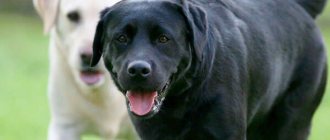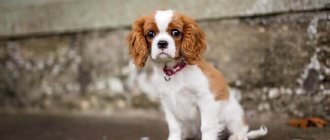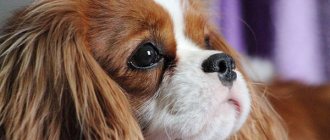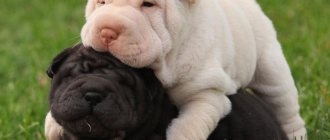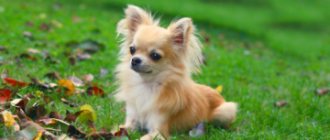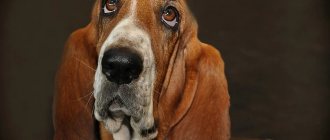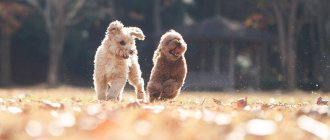The Golden Retriever is a breed of luxurious, noble dog known as Russian circus dogs. For a long time it was considered the descendants of Caucasian breeds. Today, retrievers are the true love of housewives, small children and advertising producers. In the West, retrievers are considered very popular large dogs for breeding in private homes. The Golden Retriever dog belongs to the conventional “sporting” breed, bred by the British at the end of the 19th century by crossing two breeds:
- Spaniel (tweed water);
- Yellow Retriever.
History of the breed
For many years, the origins of this breed have been shrouded in mystery: Goldens are said to have been bred from the Flat-Coated Retriever (which are historically black or fawn in color) and the Tweed Water Spaniel.
Golden Retriever is an excellent choice
Over time, other crosses were made, which is why the modern retriever acquired a stronger body and sensitive charm. Then the dog was taken from England to Russia, and the first puppy was born in 1991.
Pros and cons of the breed
Golden Golden has a wonderful character; it can become a pet in any family, even a large one. It would seem that this breed has absolutely no disadvantages and every person can maintain it.
But in fact, even goldens have their drawbacks, and they are completely unsuitable for those who do not have the opportunity to devote enough time to their pet. So before buying a retriever puppy, you should familiarize yourself with all the advantages and disadvantages of the breed, and then decide whether it is your dog or not.
Advantages:
1. Beautiful appearance, especially coat color. 2. Friendliness and lack of aggression. 3. Hunting instinct developed from birth. 4. Mind, intelligence, intelligence. 5. Easy to train. 6. Ability to perform circus tricks. 7. Excellent service qualities. 8. Excellent attitude towards children. 9. Easy care. 10. Get along well with other pets.
Retriever: description of the breed
It is very easy to recognize a Golden Retriever on the street - this is a beautiful, athletically built, muscular dog with a powerful long neck and tail. The ears are hanging, medium in size and set at eye level.
The dog has straight (rarely wavy) coat, which does not allow water to pass through well. Representatives of this breed have been used for many years for hunting, for example, duck.
The standardized color ranges from golden to cream. White is considered breeding.
The retriever has a straight coat that does not allow water to pass through well.
Features of care
In addition to the general rules of dog care (brushing, brushing teeth and ears, trimming nails), owners of Golden Retrievers also need to pay attention to their pets’ coat.
- Wool
The Golden Retriever is a long-haired dog that requires a certain amount of grooming. Firstly, it is necessary to comb your pet with a brush that allows you to capture all layers of fur, otherwise there is a possibility of tangles forming, which not only worsen the appearance of the animal, but also provoke skin problems.
It is necessary to wash the dog as it gets dirty, not forgetting to moisturize and nourish the coat with special products to maintain an aesthetic appearance.
Owners of Golden Retrievers may notice that when washing their dogs, they cannot wet and then dry their pet’s coat for a long time - this is due to the characteristics of the undercoat, which protects the dog from excessive wetness and hypothermia.
- Ears
Your dog's ears should be checked regularly (once every 1-2 weeks). When plaque or discharge appears in your pet's ears, it is necessary to assess how healthy the dog is, and whether it is enough for her to simply clean the dirt from her ear, or whether this is evidence of a more serious condition.
- Teeth
Retrievers are dogs with healthy teeth, but hygiene is important: brushing, using special pastes or special food to maintain healthy teeth. For example, PRO PLAN treat for maintaining oral health.
- Claws
Nails should be trimmed at least once every 10-14 days. Long claws interfere with the correct positioning of the paws, deteriorate the health of the joints, and cause discomfort to the animal. You need to purchase a special nail clipper.
Character
As mentioned above, the Golden is a classic companion dog. She is absolutely not suitable as a security guard, as she has a trusting and friendly character.
She needs to be raised from childhood not to approach strangers, otherwise she will treat everyone with warmth, and she can be easily taken away by a stranger.
If there is a child in the house, then the golden retriever will become his best friend and companion. Such a dog can teach responsibility and at the same time help the baby become more active and healthier.
The retriever has a very docile and calm character, he is sensitive to changes in mood, so he is easy to train.
If you are planning to buy a dog not so much for yourself as for hunting, then pay attention to duck or snipe diplomas from the parents of the future pet. The vast majority of retriever owners are hunters.
The retriever has a very docile and calm character.
Is a dog right for me?
You make a friend for 10–12 years. For interaction with him to be a joy and not a burden, your characters must match. You will become friends with a Golden Retriever if:
- you love active recreation and physical activity, prefer hiking to home gatherings;
- You are more of an extrovert, tend to express emotions and love when people show affection towards you;
- you are inspired by the thought of training a retriever, taking a training course together, exercising and having fun - for example, agility (a sport where the pet and owner overcome obstacles together);
- you don’t need a dog for protection - a golden dog is unlikely to become a good watchman;
- If you would like to knit yourself a sweater from dog hair in the future - Golden is perfect for this!
Parenting Tips
Just like interacting with an adult dog, raising a Golden puppy brings joy and many positive emotions.
Raising an animal correctly and accustoming it to the necessary procedures and actions is not at all difficult.
The main secret of a good result that can be achieved after the animal leaves the nursery is a friendly attitude, without any aggression or screaming.
At the same time, the basic rules of upbringing that must be instilled in the animal are:
- love of cleanliness;
- calm reaction to street stimuli;
- correct relationship with the owner and household members.
From the first days, after the baby golden labrador left the nursery and appeared in the home (if he has all the necessary vaccinations), he can be taught to go to the toilet outside.
With proper upbringing, a golden dog should ask for a walk from the age of six months.
It is important to note that the owners will need patience here. Do not physically punish the animal under any circumstances: love and understanding will bear fruit.
If the kennel is not responsible for the availability of vaccinations, it is important to ensure that the puppy has the opportunity to go to the toilet in the house.
The following will help you properly set up a corner for your golden labrador::
People are concerned about hygiene in their own home, so they believe that after bringing a Golden into the house, it is necessary to remove all carpets.
This decision is not correct, since at a young age the ligaments and tendons of a Labrador are not particularly strong.
By teaching a baby to “walk” on tiles or linoleum, the owner can cause considerable harm to the pet’s health.
Constant tension in the leg muscles of an animal at this age increases the risk of developing certain diseases. The result of such actions is dysplasia.
To avoid possible problems, experts recommend covering the space reserved for the animal’s habitat with inexpensive carpet, porous, or rubber mats that can be easily washed and cleaned.
When teaching your Golden Labrador to hygiene, you need to know that small retrievers are not protected from infections.
Diseases and the negative effects of microorganisms can be avoided by keeping the house clean. For example, you cannot leave street shoes in the hallway that an animal can reach.
You cannot leave food brought from a store or market in the accessible vicinity. You should also not allow him to chew on objects and toys of other pets living in the house. When taking your golden dog out for a walk, you should not drive it through puddles and mud.
Your Golden Labrador puppy needs frequent but short walks outside.
However, you need to ensure that your pet does not become overtired. Free running and the opportunity to frolic, as well as leisurely exploration of park paths and lawns, will be beneficial.
As the dog grows, it is recommended to walk the dog for about an hour and a half in the morning, up to 20 minutes in the middle of the day and a few minutes in the evening.
Do not force your Golden to run for hours at a time, this is not good for your Golden Retriever.
Interesting Facts
There are a lot of interesting things associated with any breed. And the golden retriever was no exception to the rule:
- The breed has an alternative name - Golden Retriever. Golden in English means “golden”. Retrieve is translated as “to find”, “to get”.
- A golden retriever named Charlie was included in the Guinness Book of Records as the owner of the most deafening voice. Its bark sounded at a volume of 113.1 dB, which is roughly comparable to the noise of a working pneumatic drill and 42 times louder than everyday human speech.
- Thanks to their charming appearance and natural artistry, dogs of this breed often appear on movie screens. They participated in the filming of such films as “The King of the Air”, “The Road Home”, “The Incredible World through the Eyes of Enzo”, “The Case of Old Drama”, “Napoleon”, “Golden Winter”, etc.
- According to research by American psychology professor Stanley Coren, the Golden Retriever ranks 4th out of 133 in terms of intelligence.
Retriever dog training
A dog of this breed is considered one of the smartest, but even with training you will need patience and all kinds of encouragement in the form of treats. Since the retriever is a sociable dog, you should focus on commands such as sit, wait, next to and lie down. Don’t worry if you don’t succeed the first time - constant training and attention will make the animal docile and well-mannered.
Cinematographers all over the world love retrievers, because the camera loves them, they easily follow commands and do what is required of them. This is confirmed by many films with their participation, for example, “The Lovely Bones” or “King of the Air”. By the way, it is the second film that can be recommended for viewing to those who have not yet decided on a purchase, since Golden’s grace, strength and intelligence can conquer at first sight.
Characteristics of Golden
Breed definition Golden Retriever was first found in the late 19th century in Great Britain. In 1999, the international organization FCI approved the standard by which the whole world is measured in breeding. A little later, the AKC created a second standard, which is used by America and neighboring countries. The AKC standard is more detailed, but differs somewhat from the FCI.
Breed standard
The Golden Retriever is a gun dog with a strong body and a friendly look. The straight or wavy coat has a creamy or golden hue. The dogs are quite large and have the following height:
- Females 51-56 cm.
- Males 56-61 cm.
The Golden gives the impression of a good-natured giant with a harmonious body, balanced movements and a powerful tail.
Dog character
Golden retrievers are sociable dogs that love attention and communication. The dog is inquisitive and quickly learns new commands. Since retrievers are hunters at heart, they have instincts that greatly influence their character. If not given enough exercise, a Golden can be overly active at home and because of this, surrounding objects and people may suffer:
- Furniture is chewed.
- Accessible things (cups, plants, books, etc.) are dropped.
- Uncontrollable barking begins.
How long do golden retrievers live?
Goldens usually live 10-12 years, but with proper care and timely visits to the veterinarian they can easily live up to 14-15 years. To increase the lifespan of a dog, you need not only to feed it properly and walk it, but also to give it vaccinations in a timely manner and carry out preventive measures. Scientists have found that the lifespan of dogs depends not only on lifestyle, but also on hereditary factors.
Common Teaching Mistakes
When practicing skills, you need to ensure that the trainer’s actions are logical and understandable to the dog. Typical mistakes when learning:
- the requirement to strictly follow orders from a tired animal;
- pronouncing a command (for example, “sit!”) after physical impact (if it is used), and not before it;
- aggressive intonation, raised voice, impulsive gestures;
- repetition of the same pose when giving commands (the initial conditions need to be changed);
- practicing several skills mixed;
- change in word form;
- incorrect or uncertain intonation (the command should be given calmly, clearly, peremptorily, but without anger in the voice);
- non-compliance with the training schedule (you need to exercise daily, preferably more than once, but in a gentle manner in order to maintain and fuel the puppy’s interest in learning);
- neglect of praise and rewards (it is better to overdo it with enthusiasm for the pet’s success than to under-reward it).
Am I suitable for a dog?
Before choosing a breed, you need to assess whether you are able to meet the needs of your pet. Only a physically and mentally healthy dog can become a true friend, bringing joy, not problems. A Golden Retriever will take root in your home if:
- your children are old enough to understand how to behave with a dog and what not to do;
- you work at home, close to home, not every day, on a flexible schedule - in general, you are absent for more than 12 hours, 5 days a week;
- you live in an area where veterinary care is available: unfortunately, goldens do not have strong immunity and impeccable health;
- you have the opportunity to purchase far from cheap food for your retriever.
Caring for a Golden Retriever
- The retriever is very shaggy, so it needs constant and thorough brushing. Your pet sheds twice a year, so you need to pay special attention to its coat.
Retriever grooming glove
- Animals of this breed love to eat. The breed standard stipulates a weight of up to 40 kg, so you must control your pet’s diet and not buy into its provocation if you do not want to provoke obesity. You can feed your dog prepared or natural food. In the latter case, it is necessary to monitor the diversity of the diet.
- Dogs of this breed are literally dependent on water, so it will be good if you find some clean body of water for your pet. Goldens will happily splash in the water all day long, carry balls, and chase frisbees and sticks.
- Retrievers are very active dogs, so you should spend at least an hour walking them. Constantly provide your pet with exercise, otherwise he can quickly become lazy and gain weight.
What needs to be done?
“Maintenance” of a retriever consists of a number of maintenance that the owner must carry out regularly in order to keep golden friend in good condition - this means both appearance (in particular, the absence of an unpleasant odor ) and general health. First of all, it is important:
- hygiene (cleaning ears, teeth, washing paws after walks);
- grooming (combing out excess hair, trimming nails, sometimes washing);
- daily examination, allowing timely identification of disease symptoms.
Teeth cleaning
A dog's mouth, like our mouth, requires cleaning, otherwise pathogenic bacteria will multiply on the mucous membranes and surfaces of the teeth. Inflammation and bad breath are unnecessary phenomena for a Golden Retriever, so we will teach the puppy to use toothpaste and a brush. Important points:
- “human” paste is not suitable - it contains unnecessary additives, and aggressive flavorings can harm the hunter’s sensitive sense of smell;
- you need a special brush - you can buy it at a pet store (it is especially convenient to use a brush in the form of a fingertip).
Start brushing the outer teeth, moving toward the inside of the jaw as your dog becomes accustomed to brushing. Do not try to brush all your teeth at once if your pet resists; it is better to postpone part of the procedure until tomorrow than to cause a persistent aversion to hygiene in him. Once you've dealt with the oral cavity, don't forget to reward your Golden!
When the dog is completely accustomed to the toothpaste and brush and can sit quietly throughout the entire process, teeth brushing will need to be done every two to three days.
Ear care
Golden retrievers are the owners of gorgeous furry ears, the care of which, like other grooming , should begin while the pet is still a puppy . Healthy ears do not require cleaning, but they should still be examined regularly. Contact your veterinarian if:
- the epithelium is damaged or inflamed;
- the ear canal is clogged;
- there is discharge or an unpleasant odor.
Most likely, the doctor will prescribe self-treatment of the ears with special solutions. Ask to show you how this is done right in the clinic - there is nothing complicated about the procedure.
It may be necessary to wash the inside surface of the ears if the dog gets dirty. Use lotion and a cotton pad, be careful not to pour liquid into the ear canal: this can lead to negative consequences, including the dog losing hearing.
Combing and washing
Caring for a Golden Retriever's coat (especially when shedding ) is the most time-consuming of all procedures. If you are just planning to get a Golden, be prepared for the fact that you will not be able to completely get rid of the fur: no matter how you remove it, there will always be some amount of hair at home. There are also advantages to this: the wool can be collected and knitted into a healing belt.
Goldens are the “coolest” of the retriever , and owners need to adapt to turn grooming from a feat into a routine task. For combing, you can use a comb and a furminator, but many owners of Goldens advise against using the latter, as they believe that it spoils the undercoat. You can experiment on your own and make your own decision.
Especially carefully and carefully you need to comb the dewlap, which all golden retrievers on the tail , belly and inner surface of the paws.
to bathe your Golden Retriever it can be done to speed up shedding, or if you notice that he's starting to smell like a dog It is better to use a special dog shampoo rather than your own. The approximate frequency of washing, according to reviews from Golden owners, is 1–2 times a month.
Be careful when drying your dog: it is best when the coat dries naturally. However, golden retrievers (especially puppies ) are susceptible to colds, and their health requires care and careful attention. Make sure that there are no drafts in the room where your pet is after bathing; during the cold season, use a hairdryer or refuse washing in favor of dry brushing the fur.
All these tips are relevant for dogs that do not participate in exhibitions - pets. If you plan to show your Golden, there is a whole range of grooming that you will need to learn (or leave to the professionals).
Feeding
Feed your Golden Retriever at the same time every day. Feeding frequency:
- at 2-4 months. — 5 rubles/day;
- at 4-6 months. - 4 times;
- at 6-12 months. - 3 times;
- after a year - 2 rubles.
After feeding, the bowl is removed, even if there is food left there.
Dry food
It would be more correct to purchase “Premium” or “SuperPremium” food for your dog. Cheaper ones are not able to meet the body's needs and often cause allergies. When choosing, keep in mind that foods containing a lot of protein are not suitable for puppies.
If your pet becomes overweight, reduce the amount of food. You can temporarily switch him to diet food. If allergy symptoms appear, buy special hypoallergenic brands (Nutra Choice, Doctor Alders, etc.). This food contains lamb meat, fish, and rice.
Until the puppy is 3 months old, soak dry food in warm water until it becomes mushy. A bowl of clean drinking water should be freely available. If you have chosen dry food, natural food or any vitamin or mineral supplements, you cannot give it. This will cause diseases of the gastrointestinal tract, kidneys, and liver. You can feed crackers and pieces of fruit as treats.
Natural food
Food from the owner’s table is not suitable for the dog; it must be prepared separately. The basis of the menu: protein products (meat, dairy, eggs). Additionally, they provide porridge, vegetables, and fruits. Approximate composition of the daily diet:
Age 2-3 months:
- 250 g meat,
- 1 egg
- 350 ml milk,
- 150 g cottage cheese,
- 1 tsp. l. rast. oils,
- 150 g porridge,
- 150 g vegetables.
At 3-4 months:
- 350 g meat,
- 1 egg
- 200 g cottage cheese,
- 450 ml fermented milk drinks,
- 1 tsp. l. rast. oils,
- 200 g vegetables,
- 150 g porridge.
At 4-6 months:
- 450 g meat,
- 1 egg (2 rubles/week),
- 200 g cottage cheese,
- 0.5 l yogurt, kefir,
- 200 g vegetables,
- 1 tsp. l. rast. oils,
- 200 g porridge.
At 6-8 months:
- 0.6 kg of meat (instead they give fish 2 rubles per week),
- 1 egg (1 rub./week),
- 350 g cottage cheese,
- 250 ml kefir, yogurt,
- 250 g vegetables,
- 1 tsp. l. rast. oils,
- 250 g porridge.
From 8 months:
- 0.7 kg of meat (instead they give fish 2 rubles per week),
- 0.5 kg cottage cheese,
- 250 ml kefir, yogurt,
- 0.4 kg of vegetables,
- 1 tsp. l. sunflower oil,
- 300 g porridge.
How to feed:
- Thaw the meat, cut into pieces. Serve raw or scald with boiling water (boil lightly). Minced meat and pork are not fed.
- By-products are pre-boiled and given from 4 months.
- Only sea fish is given (boiled, without bones).
- Stew vegetables (beets, carrots, zucchini, pumpkin), finely chop the greens, add everything to the porridge with meat.
- Cereals (rice, rolled oats, buckwheat) - cook a fairly thick porridge.
- Boil the eggs first.
- Bones - Buy only beef knuckles (not ribs, not tubular).
As toys, give your puppy an apple and whole carrots. Include vitamin and mineral supplements and multivitamins in your diet according to the instructions on the package. Starting from 4 months, bait containing glucosamine and chondroitin is needed. They promote healthy cartilage and joints.
Feeding puppies and lactating bitches
Starting from the 2nd month. During pregnancy, give your dog food 3-4 times a day in small portions. Increase your daily ration by 1.5-2 times. Include in the menu:
- boiled poultry;
- good quality meat;
- lean fish;
- porridge (rice, buckwheat);
- raw tripe (no fat);
- boiled offal;
- low-fat cottage cheese, cheese, fermented milk drinks;
- boiled egg (2-3 rubles per week);
- milk - up to 1 liter per day (if well tolerated);
- vegetables (grated raw carrots, tomatoes, boiled zucchini and pumpkin):
- greens (finely chopped parsley, lettuce, scalded nettle);
- fruits (apples, pears);
- dried fruits;
- drying, crackers.
Mineral bait with a high content of calcium and phosphorus is required. A week before giving birth, increase the amount of easily digestible protein (poultry, fish), while simultaneously reducing the amount of beef.
During the first 2-3 days. after birth, give food after 6-8 hours, water should be freely available. Then transfer the dog to 4 meals a day: liquid food (porridge, milk, sour milk).
Gradually include meat soup with cereals and boiled meat (small portions) in the menu. In the second week, feed raw meat, cut into small pieces.
Give mineral and vitamin supplements. Ascorbic acid with glucose is useful (daily). From 4th to 6th week. Reduce the amount of food without reducing its calorie content. Gradually reduce the amount of fluid in your diet to reduce lactation. To stop it completely, do not give food during the day and limit the dog’s drinking.
How to choose a golden retriever puppy and what is its price
If you decide to get a golden loving bundle, you must carefully choose a nursery. Buying a dog secondhand or at the market is not recommended. Even if you are lucky enough to buy a purebred retriever, this does not mean that it will be healthy. Dogs of this breed often suffer from dysplasia or diabetes, so you must obtain all documents from the owner. If you want to buy a puppy for yourself, then pay attention to the pet class. The price of two-month-old puppies is about 25 thousand rubles in Moscow, and in Kyiv nurseries a puppy can be purchased for 8,000 UAH.
If you are going to participate in exhibitions or engage in breeding, then a show and premium dog will cost about 65 thousand rubles.
Of course, on sites such as olx or Avito you can find a puppy much cheaper, but it is unlikely that the owners will be able to boast of purebred parents and a good pedigree.
The Golden Retriever is a strong and active dog that shows little to no aggression or dominance. She is easy to train, gets along with people and other pets, does not give in to provocations and has an easy-going character. If you are a beginner and have never had a dog before, then you can start with a Golden.
Education and training
From the first days the puppy is in the house, it is necessary to educate him. First of all, the retriever must be accustomed to its name. Gradually, the number of commands increases, and the dog is given additional stress for the brain in the form of sets of exercises. In addition to everyday obedience, golden retrievers have special types of training. The most common of them is serving beaten poultry. They also often practice agility and freestyle with goldens. In order to master most commands, the services of a dog handler or handler are not required. With proper perseverance, even a beginner in the world of cynology can teach a dog basic commands.
Health and susceptibility to disease
Goldens have a fairly strong immune system, which allows them to live outside in winter and not suffer from colds due to drafts in summer. A Golden Retriever whose housing conditions do not meet breed standards may get sick more often and be weaker than its littermates.
The most common breed defects
Hip dysplasia is common among retrievers. This disease is most often inherited and is incurable, but in some cases surgery may be performed to improve the condition. In order to protect yourself from this disease, you need to check with your parents for tests for this disease.
Another common disease in the breed is atopic dermatitis. There are a lot of allergy sufferers among Goldens. It is impossible to get rid of allergies, but it is quite possible to create a menu that contains a minimum of allergens.
Vaccination
The puppy is vaccinated for the first time at 8 weeks. Revaccination with the same vaccine is carried out after 3 weeks. Since at 11 weeks it is too early for a puppy to receive a rabies vaccine, an additional vaccination is given after three months. The vaccine prevents various diseases:
- Plague.
- Parvovirus enteritis.
- Infectious hepatitis.
- Leptospirosis.
- Adenovirus.
- Rabies.
What to prepare for?
Keeping in an apartment requires the creation of conditions: the Golden Retriever is a large breed. Depending on gender and constitution, they grow up to 50–60 cm at the withers. In addition, Goldens have long hair and, like any hunting dog, are very active.
- If your living space is small, it is better to opt for a smaller and calmer breed. Despite the fact that a well-walked dog spends most of its time sleeping at home five square meters is not enough for a golden retriever
- It is necessary to equip a bed that will belong only to the dog. It should be sized and located in a place that offers maximum visibility, but at the same time not the most passable. The bed should be protected from drafts, but you should not install it near the radiator: the puppy will grow up pampered and often get sick, like children who were wrapped up in childhood.
- Golden requires long walks. You will have to go out with him at least twice a day for an hour. Teach your puppy to wash his paws after a walk from a tender age, so that there are no difficulties with a grown dog.
- Golden retrievers shed, and carpets, if you have them in your apartment , will suffer. It is advisable to sweep and vacuum every day or every other day, and wash the floor with a detergent once a week.
